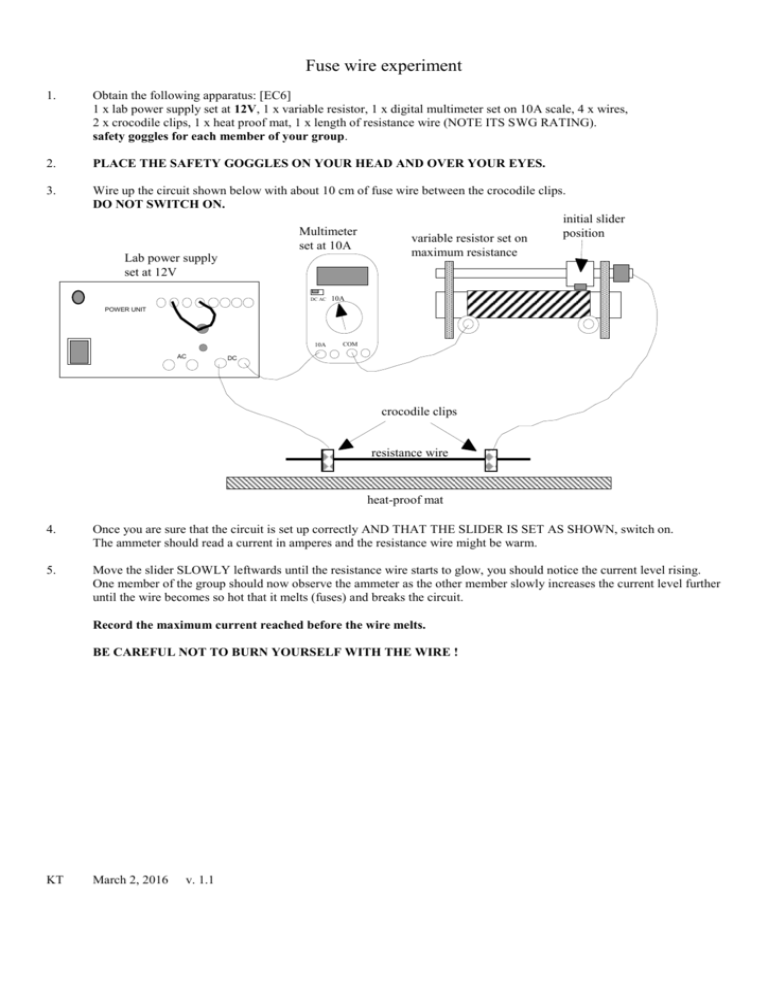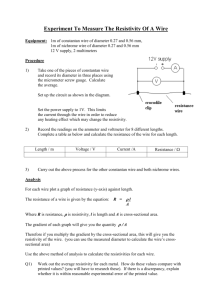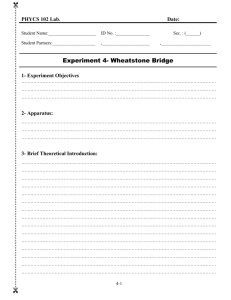FuseWireExperiment.doc
advertisement

Fuse wire experiment 1. Obtain the following apparatus: [EC6] 1 x lab power supply set at 12V, 1 x variable resistor, 1 x digital multimeter set on 10A scale, 4 x wires, 2 x crocodile clips, 1 x heat proof mat, 1 x length of resistance wire (NOTE ITS SWG RATING). safety goggles for each member of your group. 2. PLACE THE SAFETY GOGGLES ON YOUR HEAD AND OVER YOUR EYES. 3. Wire up the circuit shown below with about 10 cm of fuse wire between the crocodile clips. DO NOT SWITCH ON. initial slider Multimeter position variable resistor set on set at 10A maximum resistance Lab power supply set at 12V DC AC 10A POWER UNIT 10A AC COM DC crocodile clips resistance wire heat-proof mat 4. Once you are sure that the circuit is set up correctly AND THAT THE SLIDER IS SET AS SHOWN, switch on. The ammeter should read a current in amperes and the resistance wire might be warm. 5. Move the slider SLOWLY leftwards until the resistance wire starts to glow, you should notice the current level rising. One member of the group should now observe the ammeter as the other member slowly increases the current level further until the wire becomes so hot that it melts (fuses) and breaks the circuit. Record the maximum current reached before the wire melts. BE CAREFUL NOT TO BURN YOURSELF WITH THE WIRE ! KT March 2, 2016 v. 1.1 6. Copy into your book the table shown below. Record your current reading into this table, in the1st time reading column. Make sure you insert your reading on the correct row. Resistance wire thickness Fusing current (A) SWG number diameter (mm) area (mm2) 32 34 36 38 40 42 0. 274 0. 237 0. 193 0. 152 0. 122 0. 102 0. 0590 0. 0441 0. 0293 0. 0181 0. 0117 0. 0082 1st time 2nd time average 7. RETURN THE SLIDER BACK TO THE RIGHTHAND END then repeat with another length of the SAME SWG. (Note SWG = standard wire gauge). Insert this value in the 2nd time column. 8. RETURN THE SLIDER BACK TO THE RIGHTHAND END then repeat stages 5 and 6 with the other wires. Each time note the SWG and RETURN THE SLIDER BACK TO THE RIGHTHAND END before starting. 9. Calculate the average fusing current for each wire thickness and insert your answers in the last column of the table. 10. Draw the following graphs: (a) Fusing current in amperes [Y-axis] against wire diameter in mm [X-axis]. (b) Fusing current in amperes [Y-axis] against wire area in mm2 [X-axis]. 11. ATTACH BOTH GRAPHS AND THIS SHEET TO YOUR NOTE BOOK. 12. Read the following statement: Two quantities are proportional to each other if when one of them is doubled, the other doubles as well. If these quantities are plotted against each other, the graph produced is a STRAIGHT line that passes THROUGH the ORIGIN. 13. Answer the following questions: (a) Does the fusing current increase or decrease with the diameter of the wire? (b) Does the fusing current increase or decrease with the area of the wire? (c) Is the fusing current proportional to the wire diameter? (d) Is the fusing current proportional to the wire area? (e) Do you believe that the fusing current depends on the length of the resistance wire? (f) Explain your answer to part (e). KT March 2, 2016 v. 1.1








